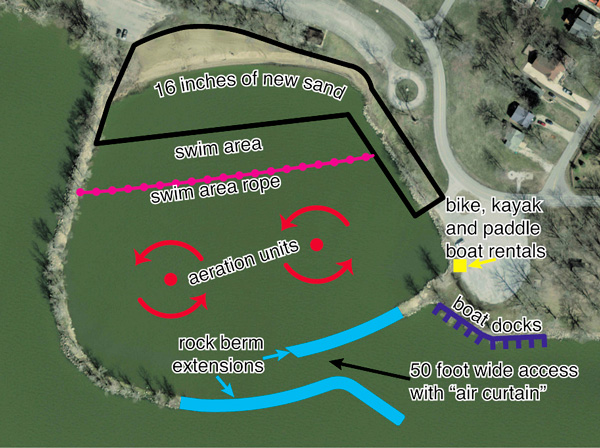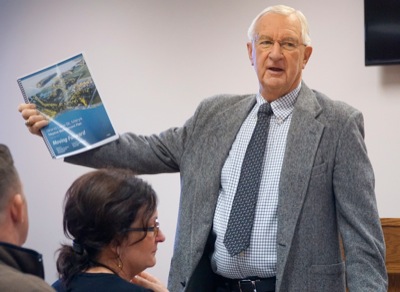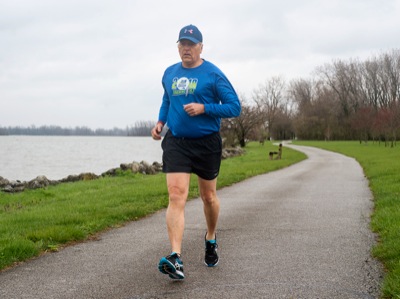Friday, April 27th, 2018
West Beach project to kick off soon
Aim to allow swimming in Grand Lake
By William Kincaid

Submitted Photo
The Ohio Department of Natural Resources, working with the Lake Restoration Commission, wants to return swimming to West Beach near Villa Nova.
CELINA - State and local officials this summer will launch an ambitious, half-million dollar endeavor to improve water quality at West Beach near Villa Nova to the point where people can once again swim there.
If successful, the project could be replicated at other local beaches and, perhaps more importantly, dispel widely held notions that all 13,500 acres of Grand Lake are potentially too dangerous for contact, officials say.
Phosphorus-fueled algal blooms have resulted in state-issued water advisories on the lake every year since 2009 and reportedly millions of dollars in lost tourism. Moreover, since July 2016, the lake has been under a no-contact advisory due to unsafe algal toxin levels. The Grand Lake area is the only one in Ohio with the distressed watershed designation.
"Everybody wants to swim in the lake, OK, and yet the warning signs are out there," Lake Restoration Commission Chairman Tom Knapke told Grand Lake Rotarians on Thursday morning.
Local officials hope to create a safe swimming site at West Beach this summer. The Ohio Department of Natural Resources has committed to spearheading an estimated $500,000 project to remove phosphorus - algae's main food source - and attempt to control the flow of water into the beach area, officials say.
The state will dredge eight acres of phosphorus-rich beach bottom, extend the current rock berm by 400 feet "to encompass most of the beach area" and install a 50-feet-long air curtain, Knapke explained.
"We don't want to (completely) enclose it because then it doesn't become part of the lake," he said.
The air curtain, Knapke said, would further help slow the exchange of water from the lake into the beach area.
Later in the day, Mercer County Economic Development Director Jared Ebbing provided additional details about the air curtain.
The curtain would create an area of greater pressure between the beach area and the open lake to keep the waters separate, he said.
The aim of the beach project is to eliminate algae's food source, limit additional phosphorus from entering the beach and keep the water aerated and moving.
"In the back channels of the lake that still have a food source (phosphorus) that hasn't been dredged out, they are algae-free because that water is constantly moving. Algae doesn't like movement. They like calm," Ebbing said.
Knapke said a person has offered to pay for alum to be applied to the water after dredging. Alum deactivates phosphorus in the water.
In addition to paying for dredging and extending the rock berm, ODNR also will cover the costs of putting in new sand on the beach and in part of the water and installing boat docks and a kiosk to rent bikes, kayaks and paddleboats, Ebbing said, adding the state capital projects budget set aside $250,000 toward the project.
Yet multiple agencies must sign off on various facets of the initiative, including the U.S. Army Corps of Engineers and Ohio History Connection, before work can begin this summer, Ebbing said.
"It's a big body of water, and it's going to take some time. You've got to be patient with us," Knapke told Rotarians.
A successful project also would greatly help reshape negative perceptions of the lake, Ebbing argued.
State-issued advisories are due to unsafe levels of microcystin algal toxins, which can harm the liver and cause gastrointestinal symptoms and rashes.
However, that testing is conducted in the absolute worst, most stagnant areas of the lake. When high toxicity numbers are reported, many people think the entire lake is toxic when that's not the case, Ebbing said.
"We're working toward long-term plans and solutions," he said. "But in the short term people get the worst of the worst perception and think the whole lake is toxic."
A restored beach would prove that not all areas of the lake are dangerous for contact and could help encourage people to boat and pursue other lake-area activities such as bird-watching, hiking and camping.
"I'm not trying to downplay the issue. We have an issue, but that doesn't mean you basically stay away from it (like it's) radioactive," he said.

Photo by William Kincaid/The Daily Standard
Lake Restoration Commission Chairman Tom Knapke shows Grand Lake Rotarians a copy of the Grand Lake St. Marys Adaptive Management Plan documenting actions taken to improve lake water quality and recommendations for the future.



